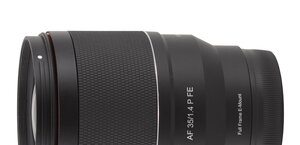Canon EF 50 mm f/1.8 II
3. Build quality
In the photo below the tested Canon EF 50 mm f/1.8 II is positioned between its 1.4/50 brother and the rival Nikkor AF 50 mm f/1.8D.
 |
Please Support UsIf you enjoy our reviews and articles, and you want us to continue our work please, support our website by donating through PayPal. The funds are going to be used for paying our editorial team, renting servers, and equipping our testing studio; only that way we will be able to continue providing you interesting content for free. |
- - - - - - - - - - - - - - - - - - - - - - - - - - - - - - - - - - - - - - - - - - - - - - - -
The Canon EF 50 mm f/1.8 II starts with a plastic mount which surrounds a plate with contacts and a ring on which its series number and the info that the lens was made in Malaysia is engraved. Its rear element, 24 mm in diameter, moves along with the whole optical system. It is in the shallowest position with the focus set at infinity and at the minimum focus it hides about 0.5 cm inside the casing.
 |
On the proper barrel of the lens, apart from the focal length marking and info concerning the minimum focusing distance, you can also find a focusing mechanism mode switch.
 |
The minimalist approach of the constructors is especially obvious when you look at the manual focus ring – it is narrow and without even a trace of any scale. Its significant initial play and working range of only 80 degrees don’t make it especially useful either. A precise setting of focus would be almost a miracle because the ring slips into the lens even under its own weight and during normal work it moves slightly sideways. The rings of its rivals are much better – when glancing at the first photo of this chapter you can find out that the Nikkor 1.8/50, a bit more expensive than the Canon, has a much better build quality, a metal mount and a genuine, fully functional manual focus ring.
Long-term wear and tear of the tested lens can be problematic to say the least; anyway service repairs seem unavoidable. There are known cases when, after just several months of usage, the elements got so loose in the plastics barrel that the images suffered of seriously high off-axis aberrations on the edges.
 |
In this category the Canon 1.8/50 hardly impresses us but you have to grant it: because of all those savings the lens tips the scale at featherweight 130 grams.
The front element of the lens is just 33 mm in diameter, slightly recessed in the tube and surrounded by a filter thread which doesn’t rotate and is 52 mm in diameter.
Inside the lens you find 6 elements in 5 groups. There are neither aspherical elements among them nor those made of low-dispersion glass. There is also an aperture with five blades (which makes the Canon lag behind its rivals) which can be closed maximally to f/22.

It’s also worth noticing that we measured precisely the parameters of the tested lens. It’s real focal length is 51.1 mm (with an error level of 0.16 mm) and its real maximum relative aperture amounts to f/1.82.
The standard accessory kit of the lens was reduced to just two caps, as it befits its minimalist design.
 |






